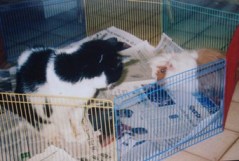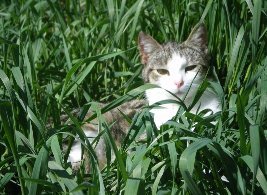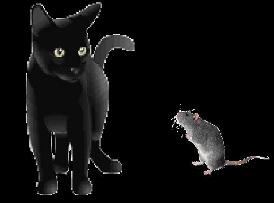Interactions with other species
 The domestic cat has developed to have beneficial
relationships with many other animals (and plants). It is much
easier for younger cat- it will just take a little more work on
the owners part to help an older, more mature cat to
develop mutual relationships with others.
The domestic cat has developed to have beneficial
relationships with many other animals (and plants). It is much
easier for younger cat- it will just take a little more work on
the owners part to help an older, more mature cat to
develop mutual relationships with others.
 One sure sign that a cat is friendly with others, is to watch
its body language. Upon approaching, the cats tail should be
straight up in the air and the back should not be arched. Also,
the ears should be sticking upward instead of flattened to the
head.
One sure sign that a cat is friendly with others, is to watch
its body language. Upon approaching, the cats tail should be
straight up in the air and the back should not be arched. Also,
the ears should be sticking upward instead of flattened to the
head.
 Some relationships-especially with
dogs- are thought to not
be so harmonious. As is seen on the image to the left- my dog
bombarded my cat Jasmine. Jasmine's feet are in a protective
stance and his ears are pushed down.
Some relationships-especially with
dogs- are thought to not
be so harmonious. As is seen on the image to the left- my dog
bombarded my cat Jasmine. Jasmine's feet are in a protective
stance and his ears are pushed down.
 However, a relationship with dogs can blossom into a
beautiful friendship. The different species are known to play
together, sleep together, and even help clean one another. In
this picture, all the animals seem relaxed and comfortable with
each other.
However, a relationship with dogs can blossom into a
beautiful friendship. The different species are known to play
together, sleep together, and even help clean one another. In
this picture, all the animals seem relaxed and comfortable with
each other.
 Another species that all types of cats are
very fond of is the Nepeta cataria, or catnip. This
plant is thought around the world to be a cat aphrodisiac. Cats
are attracted to the oil in the plant and have keen sensory
skills when it comes to finding this organism.
Another species that all types of cats are
very fond of is the Nepeta cataria, or catnip. This
plant is thought around the world to be a cat aphrodisiac. Cats
are attracted to the oil in the plant and have keen sensory
skills when it comes to finding this organism.
 Many cats have the uncanny ability to talk to
birds. They may sit right next to a feeding area and mimic the
sounds the birds make. This is a predatory ability for cats to
help them draw in their prey. It is quite interesting to watch a
cat display this behavior.
Many cats have the uncanny ability to talk to
birds. They may sit right next to a feeding area and mimic the
sounds the birds make. This is a predatory ability for cats to
help them draw in their prey. It is quite interesting to watch a
cat display this behavior.
 Not only are cats predatory to birds, but they are also the
number one enemy of rodents, such as
mice and rats. Many people
may get a cat to keep the infestation of vermin in check. In
fact, it was this job that first made cats a primary pet (see
history).
Not only are cats predatory to birds, but they are also the
number one enemy of rodents, such as
mice and rats. Many people
may get a cat to keep the infestation of vermin in check. In
fact, it was this job that first made cats a primary pet (see
history).
Cats also have many interactions with other
species that are not beneficial to them. For example,
 there
are many diseases and infections that can affect a cat. Ear
mites is one ear infection that many cats suffer from. The ear
mite, Otodectes cynotis, is a microscopic tick-like
organism. For such a small creature, it causes cats many
problems and irritation. This is a 'socialization' infection,
which means it can spread from one animal to another. The most
common sign of a cat having ear mites is a black discharge from
the ear. Also, an infected cat tends to shake its head
constantly and emit a weird smell.
there
are many diseases and infections that can affect a cat. Ear
mites is one ear infection that many cats suffer from. The ear
mite, Otodectes cynotis, is a microscopic tick-like
organism. For such a small creature, it causes cats many
problems and irritation. This is a 'socialization' infection,
which means it can spread from one animal to another. The most
common sign of a cat having ear mites is a black discharge from
the ear. Also, an infected cat tends to shake its head
constantly and emit a weird smell.
 Also,
there are many infections of the eyes and ears that are unknown
right now. They may follow the same symptoms of ear mites, but
may not be a socialization infection. The best thing to do, is
take your cat to the veterinarian and have tests done. Sometimes
just a check-up at the vet will save your cat's life.
Also,
there are many infections of the eyes and ears that are unknown
right now. They may follow the same symptoms of ear mites, but
may not be a socialization infection. The best thing to do, is
take your cat to the veterinarian and have tests done. Sometimes
just a check-up at the vet will save your cat's life.
To learn more about interacting with other species and about the nutrition of cats, click here.